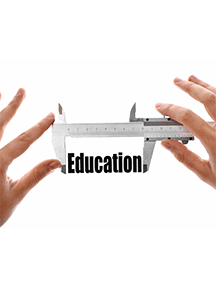By Sophie Lewis
On December 19, 2014, the U.S. Department of Education issued the preliminary framework for what will eventually become a new college ratings system. The system, which according to the Education Department’s website, is intended to “expand college opportunity by recognizing institutions that: excel at enrolling students from all backgrounds, focus on maintaining affordability, and succeed at helping all students graduate.” The proposed ratings system, which has already incited chatter among higher education professionals and students alike, has faced a great number of difficulties and delays in its implementation.
Writing for Inside Higher Education, Michael Stratford quotes Tom Weko, one of the staff members involved with policy and budget in the education department, as he describes the challenges the department faced in constructing this particular policy: “If you can’t figure out what the problem is that you’re trying to fix, you’re at high risk for wheel spinning.” Weko also adds that the department has had to “come up with creative ways to combine or mix other federal sources of data, such as the Internal Revenue Service or Social Security Administration.”
Critics ask why the government needs to establish a college ratings system at all. Naysayers argue that the government has no business rating private institutions, and that it will hurt smaller colleges and reduce their ability to attract diverse and talented students. Proponents of the system, by contrast, argue that this new policy will enable the government to hold institutions accountable for the taxpayer money that is spent on grants and loans each year ($150 billion per year, on average), and it will also help students and parents feel less overwhelmed by the application process.
The Department of Education has been quick to point out that its proposed system will not be a rankings system, but a ratings system; institutions will be evaluated according to broad categories that highlight significant successes and weaknesses, rather than a numerical ordering. Similarly, the department’s ratings will group colleges and universities strategically in order to fairly compare institutions. Though the guidelines set out in this preliminary framework for these proposed categories are vague, they are intended to start a conversation among the public in the hope that the system can be organically and transparently produced.
College rankings and/or ratings are by no means new. Since the 1980s, Robert Morse has run the infamous U.S. News & World Report’s annual “College Guide,” and the guide’s influence upon college-bound students and university administrators alike was thoroughly documented Malcom Gladwell’s still-influential 2011 piece for The New Yorker titled “The Order of Things: What College Rankings Still Tell Us.”
Morse’s methodology, which relies on seven variables of varying weights such as “undergraduate academic reputation,” “graduation and freshman retention rates,” “faculty resources,” “student selectivity,” “financial resources,” graduation rate performance,” and “alumni giving,” is described in far more concrete terms in Gladwell’s piece than the Education Department’s report, but the real question will be whether or not the Education Department’s ratings system provides new insights on the quality of higher education in the United States.
Gladwell writes, “An algorithm takes a slate of statistics on each college and transforms it into a single score […] it is easy to see why the U.S. News rankings are so popular. A single score allows us to judge between entities (like Yeshiva University and Penn State) that would otherwise be impossible to compare.” Unfortunately, the truth is that the U.S. News college rankings guide is far from perfect, because it is impossible to directly measure the myriad factors that make up a college or university’s educational value.
But how will this new ratings system impact the liberal arts? The ambiguity of the report makes it difficult to predict, but higher education’s mistrust of college ratings and rankings systems is not new. Liberal arts institutions, which aim to foster such abstract learning objectives as “inspiring intellectual curiosity” are often sent scrambling for metrics and markers to prove their merit when quantitative evaluations come along.
Evaluating the liberal arts is challenging with the current U.S. News system, and it will continue to be challenging with the advent of this new government rating system. The test for liberal arts institutions with the introduction of this new ratings system, however, will be whether or not these institutions can continue to inspire others to take up a liberal arts education in the 21st century and beyond.
Sophie Lewis is senior at Barnard College majoring in Music and English. Barnard College of Columbia University is home to the Delta of New York chapter of Phi Beta Kappa.




